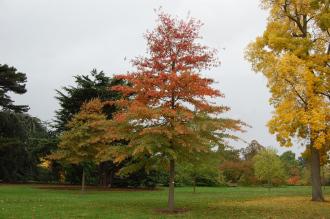
Quercus palustris (21/10/2013, Kew Gardens, London)
Position: Full sun to partial shade
Flowering period: Spring
Soil: Moist, well drained
Eventual Height: 25m
Eventual Spread: 10m
Hardiness: 4a, 4b, 5a, 5b, 6a, 6b, 7a, 7b, 8a, 8b
Family: Fagaceae
Quercus palustris is a fast growing, short lived (120 years) deciduous tree with an upright, slightly pendulous habit. Its glossy dark green leaves are deeply lobed with up to 7 lobes, up to 20cm long and 10cm broad. Its leaves turn red/ bronze in autumn before they fall. Its grey/ brown bark is shallowly fissured. Young trees may retain their dried leaves through out the winter months. Its trunk may achieve a diameter of up to 1m. Its green flowers are monoecious, the male appearing as catkins and the female appearing solitary. Its green fruit is an ellipsoid acorn which is up to 25mm long and 15mm broad, these mature to a pale brown. Its roots are shallow and fibrous.

Quercus palustris Autumn Leaf (21/10/2013, Kew Gardens, London)
Quercus palustris, commonly known as the Pin Oak or Swamp Spanish Oak, is native to central and east USA. In its native habitat it grow in poorly drained soils which flood during the dormant season.
The etymological root of the binomial name Quercus is derived from the Latin name for an Oak tree, but some authorities believe it to be derived from the Celtic quer meaning ‘fine’ and cuez meaning ‘a tree’. Palustris is from the Latin meaning ‘of marshes’.
The landscape architect may find Quercus palustris useful as a specimen tree with attractive autumn leaf color. It is well suited to soils which flood during the winter months. It is tolerant of atmospheric pollution.
Ecologically, Quercus palustris acorns are attractive to some birds and mammals.
The Royal Horticultural Society has given Quercus palustris their prestigious Award of Garden Merit in 1993.

Quercus palustris Bark (21/10/2013, Kew Gardens, London)
Quercus palustris prefers moist, fertile, well-drained soils. It prefers a neutral to acid pH of soil. This tree will tolerate wet soils.
Quercus palustris requires little maintenance.

